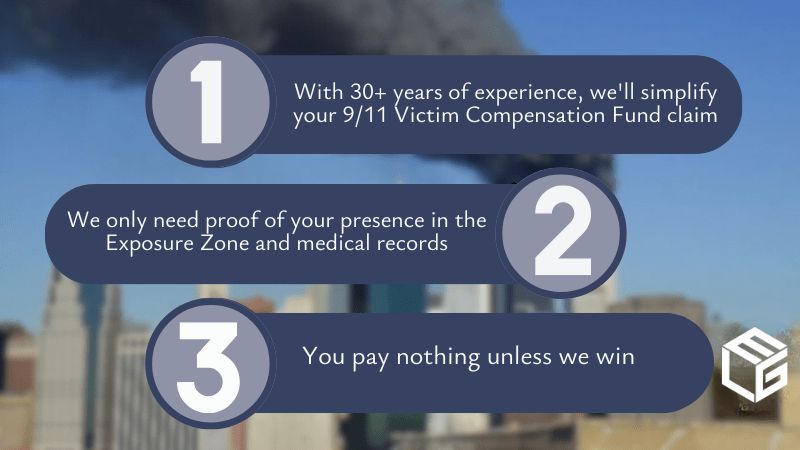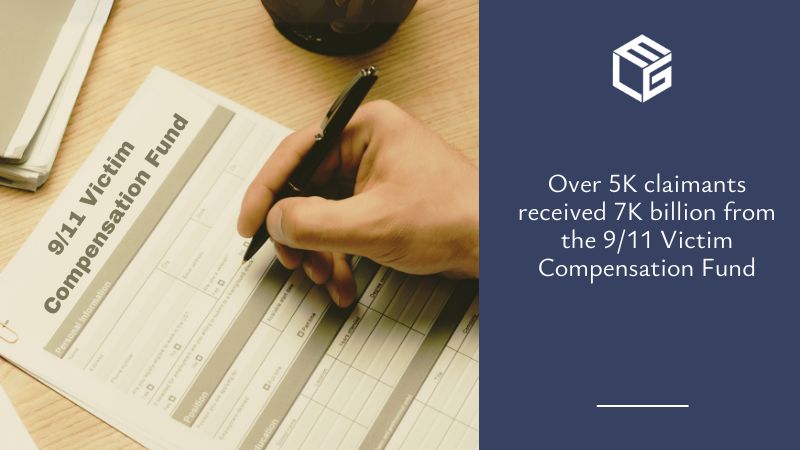-
About »
- Insulin MDL
-
Cases »
- Diseases
- Testimonials
- Government
- Contact
- Get Help Now
-

The purpose of the 9/11 Victim Compensation Fund is to provide financial compensation to people who developed health problems as a result of toxic exposure that occurred during the aftermath of the terrorist attacks years or even decades later. It offers money to New York City Fire Department active or retired members, World Trade Center general responders, and individuals in the course of ordinary employment, residence, education, or otherwise present in the Exposure Zone.
To become eligible to file a claim with the 9/11 Victim Compensation Fund, you must have been present at the World Trade Center or the surrounding New York City Exposure Zone, the Pentagon crash site, or the Shanksville, Pennsylvania crash site at some point between September 11, 2001, and May 30, 2002. If you came to struggle with a health issue as a first responder or survivor, we encourage you to contact our attorneys, who will assist you in recovering compensation.
Claim ApplicationThe history of the 9/11 Victim Compensation Fund began on September 22, 2001, several days after the terrorist attacks claimed nearly 3,000 lives.
It was created by a Congress act to provide compensation to people who were injured or lost family members in the September 11, 2001, terrorist attacks or the immediate aftermath.
Twenty years later, the Victim Compensation Fund continues to serve the 9/11 community to make sure each responder and survivor is fairly compensated for their related health conditions.
Even though the original 9/11 Victim Compensation Fund closed in the winter of 2003, the Victim Compensation Fund was later reopened. As responders and survivors kept developing severe diseases from exposure to the toxins in the dust cloud, the fund expanded multiple times until it was permanently authorized in 2019 and funded through 2090. Until December 2003, the 9/11 Victim Compensation Fund paid out a total of $7.049 billion to 5,560 claimants. Compensation is also available to those who worked or volunteered in construction and debris removal.
To become eligible for compensation from the 9/11 Victim Compensation Fund, you must have been injured or developed a disease between September 11, 2001, and May 30, 2002, as:
Furthermore, you must have one of the following injuries, diseases, or health conditions:
To know with certainty whether you qualify for compensation from the 9/11 Victim Compensation Fund, we advise you to get in touch with our diligent attorneys, who will promptly evaluate your case to determine your eligibility. If we deem you eligible, we will begin working on your case as soon as possible, as we are well aware that many 9/11 victims need money to afford treatment if they have chronic health issues.
As a result of having inhaled harmful air, responders are still developing cancers and respiratory diseases decades later. The illnesses 9/11 responders are at high risk of developing include lung cancer, asthma, ovarian cancer, chronic cough syndrome, pancreatic cancer, and mesothelioma, as asbestos was also released into the air.
These are the 9/11 occupations implying a serious risk of developing cancer or another disease due to toxic exposure:
To date, 1,469 World Trade Center Health Program members have died from airway and digestive disorders, whereas 1,366 have passed away from cancer.
When the plane crashed, it resulted in the collapse of the Twin Towers, which created massive dust clouds filling the air and leaving hundreds of highly populated city blocks covered with ash, debris, and harmful particles, including asbestos, metals, silica, concrete, and glass.
The dust from the collapsed buildings was "wildly toxic", according to air pollution expert and University of California Davis Professor Emeritus Thomas Cahill. Much of the debris resulting from the collapse of the Twin Towers was pulverized concrete, which is known to cause silicosis upon inhalation.
9/11 victims might have been exposed to the following toxic or dangerous substances and materials during the aftermath of the attack:
Over 70 known carcinogens and a myriad of toxic chemicals were released into the air across Lower Manhattan on the day of the 9/11 attack. "The debris pile acted like a chemical factory. It cooked together the components of the buildings and their contents, including enormous numbers of computers, and gave off gases of toxic metals, acids, and organics," according to atmospheric scientist Thomas Cahill. More than 15,000 people in the 9/11 community have been diagnosed with cancer, and over 2,000 have died of those cancers.
With over 30 years of experience in toxic exposure and personal injury cases, our attorneys will gladly help you obtain financial compensation from the 9/11 Victim Compensation Fund. The only documents we will request to assess your case are evidence of your injury or illness being caused by the terrorist attacks or the aftermath and your medical records with your diagnosis. We will carefully and thoroughly review your case to determine whether you are eligible for compensation. Eventually, if our endeavors are successful, you will recover the money you deserve for your unjust suffering.


